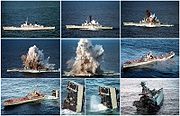
Magnetic pistol
Encyclopedia

Torpedo
The modern torpedo is a self-propelled missile weapon with an explosive warhead, launched above or below the water surface, propelled underwater towards a target, and designed to detonate either on contact with it or in proximity to it.The term torpedo was originally employed for...
or naval mine
Naval mine
A naval mine is a self-contained explosive device placed in water to destroy surface ships or submarines. Unlike depth charges, mines are deposited and left to wait until they are triggered by the approach of, or contact with, an enemy vessel...
that detects its target by its magnetic field, and triggers the fuse for detonation. A device to detonate a torpedo or mine on contact with a ship or submarine is known as a contact pistol.
A magnetic pistol on a mine will allow the mine to detonate in proximity to a target, rather than actual contact, allowing the mine to cover a larger effective area.
A magnetic pistol on a torpedo allows the torpedo to detonate underneath the ship, instead on impact on the side of the ship. As an explosion underneath a ship is contained between water and the ship, far more damage will be done to the ship. The explosion will lift the ship out of the water and may break the back of the ship, splitting it in two. Any hole created by the explosion will be on the bottom, causing more flooding.
A contact pistol on a torpedo will require the torpedo to strike the side of the ship. Any hole created by the explosion will be closer towards the waterline, reducing flooding. The explosion will also dissipate into the air, reducing the damage. If the torpedo is fired too deep, the torpedo will not hit the ship. If the ship has a round or sloping bottom, the torpedo may glance off the bottom and not detonate.
During World War II
World War II
World War II, or the Second World War , was a global conflict lasting from 1939 to 1945, involving most of the world's nations—including all of the great powers—eventually forming two opposing military alliances: the Allies and the Axis...
, magnetic pistols often exploded prematurely or not at all. The reason was that magnetic lines are more horizontal close to the equator than towards the poles. For example, the US Mark 6 magnetic pistol was designed and tested only once at 41° latitude (60° geomagnetic latitude
Geomagnetic latitude
Geomagnetic latitude is a parameter analogous to geographic latitude, except that bearing is with respect to the magnetic poles, as opposed to the geographic poles....
) at Narragansett Bay
Narragansett Bay
Narragansett Bay is a bay and estuary on the north side of Rhode Island Sound. Covering 147 mi2 , the Bay forms New England's largest estuary, which functions as an expansive natural harbor, and includes a small archipelago...
, but was primarily used in equatorial latitudes. At the equator, the signal strength to the Mark 6 magnetic pistol was only about half that of where the Mark 6 was tested. Moreover, relative velocity (i.e. when a torpedo is fired from behind or in front of a ship) would additionally change the abruptness of the magnetic signal, resulting in the magnetic pistol being triggered prematurely or not at all.
Eventually, the US Mark 6 magnetic pistol was replaced by contact pistols (which, in case of the US Mark 15 torpedo, proved to be unreliable as well).
Some ships carry degaussing
Degaussing
Degaussing is the process of decreasing or eliminating an unwanted magnetic field. It is named after Carl Friedrich Gauss, an early researcher in the field of magnetism...
equipment which will reduce the signal detected by a magnetic pistol.

